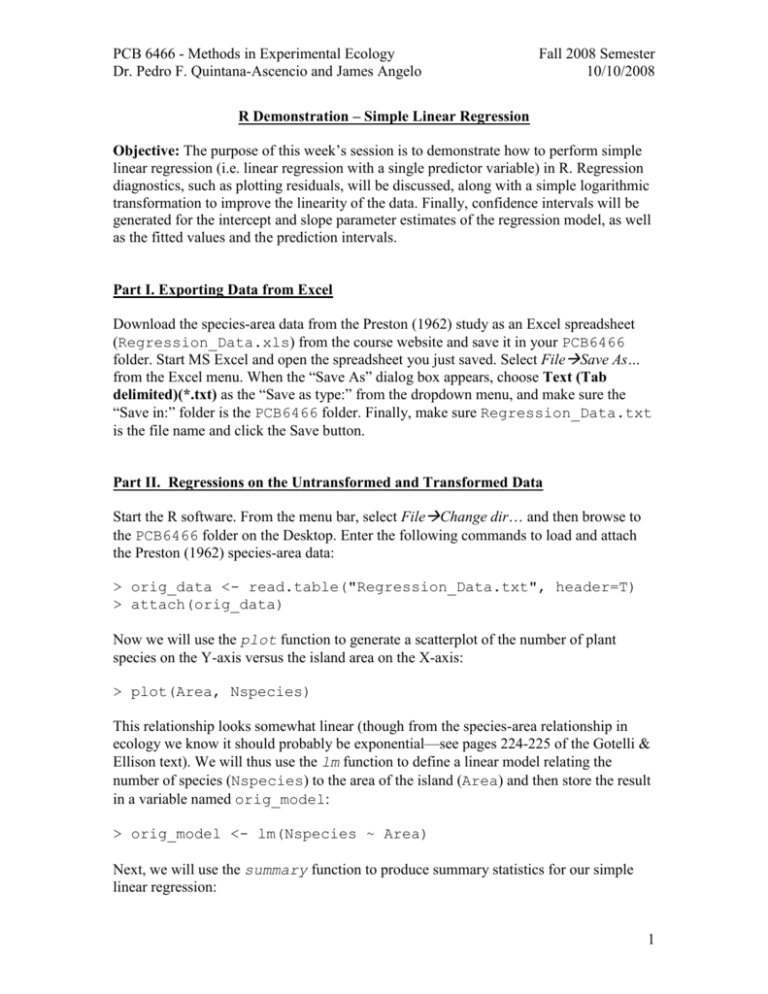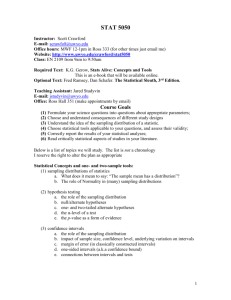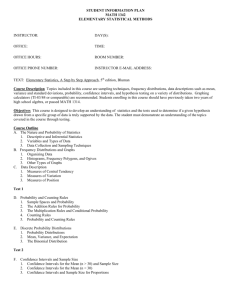Regression_R_demo
advertisement

PCB 6466 - Methods in Experimental Ecology Dr. Pedro F. Quintana-Ascencio and James Angelo Fall 2008 Semester 10/10/2008 R Demonstration – Simple Linear Regression Objective: The purpose of this week’s session is to demonstrate how to perform simple linear regression (i.e. linear regression with a single predictor variable) in R. Regression diagnostics, such as plotting residuals, will be discussed, along with a simple logarithmic transformation to improve the linearity of the data. Finally, confidence intervals will be generated for the intercept and slope parameter estimates of the regression model, as well as the fitted values and the prediction intervals. Part I. Exporting Data from Excel Download the species-area data from the Preston (1962) study as an Excel spreadsheet (Regression_Data.xls) from the course website and save it in your PCB6466 folder. Start MS Excel and open the spreadsheet you just saved. Select FileSave As… from the Excel menu. When the “Save As” dialog box appears, choose Text (Tab delimited)(*.txt) as the “Save as type:” from the dropdown menu, and make sure the “Save in:” folder is the PCB6466 folder. Finally, make sure Regression_Data.txt is the file name and click the Save button. Part II. Regressions on the Untransformed and Transformed Data Start the R software. From the menu bar, select FileChange dir… and then browse to the PCB6466 folder on the Desktop. Enter the following commands to load and attach the Preston (1962) species-area data: > orig_data <- read.table("Regression_Data.txt", header=T) > attach(orig_data) Now we will use the plot function to generate a scatterplot of the number of plant species on the Y-axis versus the island area on the X-axis: > plot(Area, Nspecies) This relationship looks somewhat linear (though from the species-area relationship in ecology we know it should probably be exponential—see pages 224-225 of the Gotelli & Ellison text). We will thus use the lm function to define a linear model relating the number of species (Nspecies) to the area of the island (Area) and then store the result in a variable named orig_model: > orig_model <- lm(Nspecies ~ Area) Next, we will use the summary function to produce summary statistics for our simple linear regression: 1 PCB 6466 - Methods in Experimental Ecology Dr. Pedro F. Quintana-Ascencio and James Angelo Fall 2008 Semester 10/10/2008 > summary(orig_model) Call: lm(formula = Nspecies ~ Area) Residuals: Min 1Q Median -88.55 -53.66 -43.56 3Q Max 21.21 216.04 Coefficients: Estimate Std. Error t value Pr(>|t|) (Intercept) 95.44410 24.38400 3.914 0.00138 ** Area 0.04534 0.01677 2.703 0.01636 * --Signif. codes: 0 ‘***’ 0.001 ‘**’ 0.01 ‘*’ 0.05 ‘.’ 0.1 ‘ ’ 1 Residual standard error: 93.72 on 15 degrees of freedom Multiple R-squared: 0.3275, Adjusted R-squared: 0.2827 F-statistic: 7.306 on 1 and 15 DF, p-value: 0.01636 There are several interesting things to note about the output of the summary function. First, the section labeled Coefficients: contains information about the regression parameter estimates. The first row is the intercept coefficient (i.e., ̂ 0 in the regression model presented in class) and the second row is the slope coefficient ( ˆ in our 1 regression model). In addition to the parameter estimate and its standard error (which we will use later to generate 95% confidence intervals for the parameters), notice that each coefficient has a t-value and P-value listed in the 3rd and 4th columns. The t-values are based on two-tailed tests of the null hypotheses that the coefficients are not statistically different from zero at the 5% significance level. Because the P-values for both coefficients are less than 0.05, we can conclude that they are both significant. The Residual standard error: is what we called the mean square residual (MSresid), and is an estimate of the variance of the residual (or random) error from the regression. The next line provides two different estimates of the coefficient of determination (R2). We will discuss these more next week when we cover the topic of Multiple Regression. Finally, the last line provides the F-ratio and P-value for the overall regression. Again, these indicate that our simple linear regression of Nspecies versus Area is significant. Since our intercept and slope coefficient estimates are statistically significant and our overall regression is statistically significant, we might feel pretty confident about our results. But, as mentioned in the lecture and the Gotelli & Ellison text, one of the most important diagnostic tests for a linear regression is to plot the residuals against the fitted values to check the validity of the homogeneity of variance assumption. We use the fitted and resid functions to obtain these values and then draw a scatterplot: > Y_hats <- fitted(orig_model) > residuals <- resid(orig_model) > plot(Y_hats, residuals) 2 Fall 2008 Semester 10/10/2008 100 50 -100 -50 0 residuals 150 200 PCB 6466 - Methods in Experimental Ecology Dr. Pedro F. Quintana-Ascencio and James Angelo 100 150 200 250 300 350 Y_hats As shown in the scatterplot above, the variance is heteroscedastic (see page 260 of Gotelli & Ellison). In this particular case, the residuals appear to decrease with the fitted values. Thus, this regression of our untransformed values also appears to violate one of the fundamental assumptions: that the variances are constant along the regression line. Given this apparent violation and our knowledge that the species-area relationship is usually exponential in nature, we can perform a transformation on both our independent and dependent variables to improve the linearity of their relationship. Specifically, we will take the base 10 logarithms of each variable using the log10 function and then round the values to 3 decimal places, as shown here: > log_Area <- round(log10(Area), 3) > log_Nspecies <- round(log10(Nspecies), 3) > plot(log_Area, log_Nspecies) 3 PCB 6466 - Methods in Experimental Ecology Dr. Pedro F. Quintana-Ascencio and James Angelo Fall 2008 Semester 10/10/2008 The scatterplot created with the plot function shows an apparent improvement in the linear relationship between the log10-transformed number of species and the log10transformed area. Now we can create a new linear model (trans_model) based on the log10-transformed variables and then perform the simple linear regression as before: > trans_model <- lm(log_Nspecies ~ log_Area) > summary(trans_model) Call: lm(formula = log_Nspecies ~ log_Area) Residuals: Min 1Q -0.59637 -0.32721 Median 0.02641 3Q 0.25975 Max 0.45590 Coefficients: Estimate Std. Error t value (Intercept) 1.31968 0.14221 9.280 log_Area 0.33068 0.07198 4.594 --Signif. codes: 0 ‘***’ 0.001 ‘**’ 0.01 Pr(>|t|) 1.32e-07 *** 0.000351 *** ‘*’ 0.05 ‘.’ 0.1 ‘ ’ 1 Residual standard error: 0.3206 on 15 degrees of freedom Multiple R-squared: 0.5845, Adjusted R-squared: 0.5568 F-statistic: 21.1 on 1 and 15 DF, p-value: 0.0003511 As was the case with the untransformed regression, the output indicates that our results are statistically significant. The P-values for the slope and intercept coefficients and the P-value for the overall regression are all highly significant (i.e., P < 0.001). Furthermore, the R2 values for the log-transformed regression are almost twice those for the untransformed model, suggesting that the log10-transformed model explains about two times the amount of the variation in our response variable. Finally, we can once again plot the residuals against the fitted values to check that the assumption of homogeneity of variance along the regression line is true: > > > > Y_hats <- fitted(trans_model) residuals <- resid(trans_model) plot(Y_hats, residuals) abline(h=0, col="red") As the scatterplot on the following page shows, the residuals appear to neither increase nor decrease in value in any systematic manner as we move along the X-axis. Thus, our log10-transformed regression appears to meet the homogeneity of variance assumption whereas our untransformed regression model did not. 4 Fall 2008 Semester 10/10/2008 0.0 -0.2 -0.6 -0.4 residuals 0.2 0.4 PCB 6466 - Methods in Experimental Ecology Dr. Pedro F. Quintana-Ascencio and James Angelo 1.2 1.4 1.6 1.8 2.0 2.2 2.4 2.6 Y_hats Part III. Confidence Intervals As discussed on pages 253-257 of the Gotelli & Ellison text, confidence intervals can be created for the intercept and slope parameters of a simple linear regression. To create these intervals, we will need to obtain estimates of the standard error for each of these parameter estimates. Fortunately, the summary function provides a way to easily obtain the standard error estimates for the coefficients: > coeffs <- summary(trans_model)$coefficients This command retrieves the coefficients as a matrix from our transformed regression model and stores them in a variable named coeffs. As shown below, the first row of the matrix contains the intercept coefficient and the second row contains the slope 5 PCB 6466 - Methods in Experimental Ecology Dr. Pedro F. Quintana-Ascencio and James Angelo Fall 2008 Semester 10/10/2008 coefficient. Each row contains the parameter and standard error estimates in the 1st and 2nd columns, respectively: > coeffs Estimate Std. Error t value Pr(>|t|) (Intercept) 1.3196772 0.14221201 9.279646 1.323873e-07 log_Area 0.3306837 0.07198184 4.593988 3.511440e-04 Next, we need the critical value from the t-distribution with n-2 degrees of freedom, which we can calculate with the following command: > t_crit <- qt(0.975, length(log_Area)-2) Now we have all the data we need to construct the 95% confidence intervals for our regression parameter estimates. The following block of code creates and displays the 95% confidence interval for β0, the intercept parameter in our regression model: > B0_hat <- coeffs[1,1] > B0_se <- coeffs[1,2] > B0_lower <- B0_hat - (B0_se * t_crit) > B0_upper <- B0_hat + (B0_se * t_crit) > cat("95% CI for B0: [", B0_lower, ", ", B0_upper, "]\n", sep="") 95% CI for B0: [1.016559, 1.622795] Similarly, the following code creates the 95% confidence interval for β1, the slope parameter in our regression model: > B1_hat <- coeffs[2,1] > B1_se <- coeffs[2,2] > B1_lower <- B1_hat - (B1_se * t_crit) > B1_upper <- B1_hat + (B1_se * t_crit) > cat("95% CI for B1: [", B1_lower, ", ", B1_upper, "]\n", sep="") 95% CI for B1: [0.1772581, 0.4841094] We can also generate 95% confidence intervals for both the fitted values and the predicted values based on our regression model. As noted on pages 255-257 of the Gotelli & Ellison text, there is a subtle but important distinction between the confidence intervals for the fitted values (i.e., the Ŷs) and those for predicted values (so-called prediction intervals). The confidence intervals for the fitted values will flare out in either direction as you move away from the mean of the predictor variable. Thus, confidence intervals for fitted values will always be smaller for interpolation than for extrapolation. On the other hand, the prediction intervals will always be wider than the fitted value confidence intervals because they incorporate greater uncertainty about the predicted value of the response variable. To generate our confidence intervals for the fitted values and the prediction intervals, we will first create a new data frame object to hold these intervals: > pred_frame <- data.frame(log_Area) 6 PCB 6466 - Methods in Experimental Ecology Dr. Pedro F. Quintana-Ascencio and James Angelo Fall 2008 Semester 10/10/2008 Our new data frame, pred_frame, starts with one row for each of the islands and a single column containing the log10-transformed area of each island. Next, we use the predict function to generate the confidence intervals for the fitted values and the prediction intervals: > conf_intervals <- predict(trans_model, int="c", newdata=pred_frame) > pred_intervals <- predict(trans_model, int="p", newdata=pred_frame) The first call to the predict function uses the int=”c” argument to indicate that confidence intervals for the fitted values should be calculated and stored in the variable conf_intervals. The subsequent call to the predict function uses the int=”p” argument to indicate that prediction intervals should be calculated and stored in the variable pred_intervals. Both of these calls will produce 95% confidence intervals, since that is the default for the predict function and we have not specified otherwise. Now we are finally ready to plot all of our results. First, we will use the familiar plot function to draw a scatterplot of the log10-transformed number of species versus the log10-transformed island areas: > plot(log_Area, log_Nspecies, ylim=range(log_Nspecies, pred_intervals)) Next, we will use the matlines function to draw the fitted regression line, the fitted value confidence intervals, and the prediction intervals. The matlines function allows us to plot multiple lines for the same points on the X-axis, which is what we need to create the lines for our confidence intervals: > matlines(pred_frame$log_Area, pred_intervals, lty=c(1,3,3), col="red") > matlines(pred_frame$log_Area, conf_intervals, lty=c(1,2,2), col="blue") The first call to the matlines function draws dotted red lines for the prediction intervals, and the second call draws dotted blue lines for the fitted value confidence intervals. The figure on the following page shows the results of all these plotting commands. If you are still confused as to what all of the lines mean, please see Figure 9.4 on page 256 of the Gotelli & Ellison text. As always, we finish our session by detaching the data we attached at the beginning of our R session: > detach(orig_data) 7 Fall 2008 Semester 10/10/2008 2.0 1.5 1.0 0.5 log_Nspecies 2.5 3.0 PCB 6466 - Methods in Experimental Ecology Dr. Pedro F. Quintana-Ascencio and James Angelo 0 1 2 3 log_Area 8








